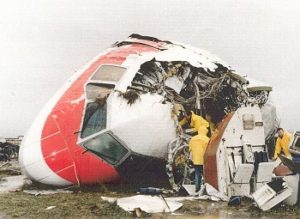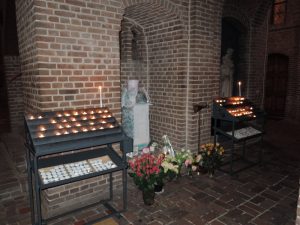“Those who cannot remember the past, are condemned to repeat it.”
George Santayana
One can wonder to what extend the captain could have been psychologically motivated to conclude the flight as planned.
From official investigation report, 2.2.3 Approach
‘About 75% of the accidents have been attributed to flight crew failure. What used to be called pilot error in the past and what we [now] prefer to call human factors. Not because we do not want to be blamed, but because we do not want the investigation and learning process to halt once it is found that the flight crew did not function as expected. We want the investigation to continue and to investigate why the flight crew did not function properly.’
From Flying is not safe, contribution by Benno Baksteen, President of Dutch Airline Pilot Association (VNV) to First World Congress on Safety of Transportation, November 1992
After over 32 years, proper accountability and responsibilty taking for the Martinair crash in Faro and its aftermath still lack.
Even after the Court procedure and verdict of January 2020 many questions -as on the approach and the actual crash- remain unanswered,
There is still too much room for biased opinions and alternative truths. An open discussion still seems not possible.
This uncertainty continues causing anxiety, frustration and doubts; and therewith hampering proper recovery.

December 21st, 1992. Delayed Martinair early morning flight MP495 crashes at Portugal Faro airport in adverse weather conditions the pilots were aware of; not: because of adverse weather conditions, such as unexpected winds.
The DC10, PH-MBN Anthony Ruys, bought from Martinair by the Royal Netherlands Air Force (destined to be converted into a KDC-10) and immediately leased back to Martinair.
As result of the crash 54 passengers and 2 flight attendants die. Over 200 occupants sustain visible physical injuries.
Also because of the aftermath, many lives become permanently damaged and limited.
Here ends the consensus on the crash, it’s (underlying) causes, the totality of the injuries and all consequences.
Also after the The Hague court verdict of January 8th, 2020 the basic question whether the pilots properly aligned the plane with Faro-runway center line, remains unanswered.
It is doubtful whether proper lessons (ICAO Annex 13) of the Martinair crash itself and, let alone, also of aftermath and personal and societal effects and consequences are, willing, to be learned.
The lack of comprehensive investigation, care and monitoring is an indication for this.
February 2025:
Was the crashed plane airworthy?
One of the remaining puzzling questions is: is a plane with a missing Airworthiness Directive still considered airworthy ?
Of engine #3 no Airworthiness Directive was submitted after the crash.
NB: Approximately 1 ½ minute before the crash the alarm was given at Faro airport because the fire crew witnessed an explosion and flames around the plane.
Are these matters connected? Should these not better looked into?
32nd annual commemoration
Saturday December 21st, 2024 in St. John’s Basilica, Laren (NH, Netherlands)
October 2023
Not ‘heavy rain’, but ‘beastly weather’ (according to the pilots)
May 2021
Even after the court verdict of 2020, Martin Schröder († October 2024), founder and at the time of the crash CEO of Martinair, denies the errors made by his pilots.
August 2017 (updated January 2018)
AvioConsult publishes a detailed analysis of the last 80 seconds of Flight MP495.
From Main Conlusions: This accident is a classic example of the fatal consequences of not applying the written and well-established procedures and protocols for a non-precision approach.
———————————————————————————
Court cases
January 8th, 2020:
verdict by The Hague court:
– the almost mythical Dutch claim of the (unexpected) windshear as cause of the crash is refuted
– actions of the Dutch Aviation and Safety Board (Board) are qualified as inaccurate and wrongful.
NB In my opinion: this attitude of Board probably / possibly negatively affected it’s cooperation to the official investigation.
Documentation:
– Dutch Aviation Council Acted Negligently and Unlawfully in 1992 Faro Plane Crash, hg.org
– Faro survivor: “There is justice now, but we remain losers” (also on ‘beastly’ weather), mbs.news
– From the verdict, need for a missed approach procedure
– The verdict. Text mostly in Dutch. From page 6 onwards, information also in English from the report of the court experts.
Causes of the crash (deficient -Dutch- investigation up to 2011)
For every complex problem there is an answer that is clear, simple, and wrong.
H. L. Mencken
The day after the crash Martin Schröder, accompanied by the then Dutch Minister of Transport, holds a press conference. In this press conference Mr Schröder states that an unexpected windshear is the cause of the crash. Some consequences of an unexpected windshear as cause of the crash are diminished responsibility and liability for Martinair.
Despite the findings in the official (= Portuguese) investigation report, the ‘unexpected windshear theory’ remains the dominant Dutch view.
This partial Dutch view is sustained by the then lack of independent crash investigation in The Netherlands.
NB In it’s letter, annex to the Investigation Report, the American NTSB also doubts the unexpected windshear theory
Witness accounts of passengers not properly used?
Some days after the crash the Martinair spokesman said that passengers were confused in their obeservations of the turbulent approach.
The doubts and questions on approach, crash and causes, as publicly raised by passengers and as formal statements given to the police seem not to have been taken seriously.
Press-on-itis as (or Get-There-itis) as, contributing, cause?
From 7 Key Points of Press-on-itis (source Skybrary)
- Press-on-it is a dangerous mental state that can affect even the best and most experienced pilots.
- Many accidents are caused, or suspected to be caused or contributed to by press-on-itis.
- Unreasonable pressure to get to the destination, whether self-generated or externally-imposed, can cause an aircrew to decide to continue to their planned destination despite conditions being unsuitable to do so.
Probable causes invite speculation and alternative thruths
Complicating factor in the aftermath is that the official investigation report only states ‘probable’ causes. This almost calls for speculation and alternative thruths.
New analysis of the facts and subsequent court cases
In February 2011 (updated December 2012), over 18 years after the plane crash, an investigation by Mr. Harry Horlings of AvioConsult is published.
In my opinion, this investigation deepens the outcome of the official Portuguese report, in which the pilots and their actions and their non-actions are chiefly regarded as leading to the crash.
Complete AvioConsult page in English on the crash.
In July 2015 the court in The Hague appointed three non-Dutch experts to look into this case and analysis of Horlings.
Because of the limited scope of the task of the experts, the lack of open discussion and the limited publication of their findings, many questions remain.
Reports:
– 2016, review by the Claimants Experts (CE) of the Interim Report of the Court Appointed Experts (CAE)
– 2017, Final Report by the CAE with CE comments
– 2017, review by the CE of the Final Report of the CAE
Too little attention for underlying causes of the crash
For a more complete picture of also underlying causes leading to the crash, starting with the management and safety culture of Martinair, a Swiss Cheese Model type of investigation is needed.
The unrest of Martinair pilots on their workload in 1998 (6 years after the crash) makes scrutiny of Martinairs Management Culture in 1992 even more important.
See, translated, articles in Dutch newspapers Trouw and NRC.

Consequences (too little attention for)
After the crash there is no detailed analysis per occupant/chair of the actual (physical) crash events.
Also an integrated care approach and monitoring (both per individual as for the total group of occupants and family members) lacks.
Partly thanks to the aftermath of crash EL Al flight 1862 in Amsterdam -three months earlier- there is attention for possible psycho trauma, as PTSD, and for grief.
The High Energy Impact nature of the crash, due to the kinetic forces, and its possible, cognitive, consequences are largely ignored.
There is hardly any attention for ‘invisible’ physical injuries of head and brain and it’s consequences, such as sensory overload.
Because of lack of interest and of the limited financial liability of Martinair (and thus limited personal injury claims) most of the practical and long term real life consequences for surviving occupants and family members remain unseen.
Because the people concerned live scattered all over The Netherlands, and even in other countries, there is even less awareness and recognition of the real impact and consequences of the crash.
There is some progress on better attention for the possible (probable?) occurence of mild head injury in plane crashes.
Mild Traumatic Brain Injury, especially Decelaration Injury, can easily be overlooked and consequences such as Mental Fatigue not recognised.
Possible co-existence of Mild Traumatic Brain Injury and Post Traumatic Stress Disorder hampers proper diagnosis and treatment
There is an need for:
– a standard comprehensive personal crash analysis per seat / per occupant
– long term monitoring of surviving occupants and family members
– attention for the negative impact of post-crash legal activities
– a world wide (Post) Crash Injury Consequences Knowledge Center (an indepent Directorate within ICAO?) and
– a Dutch National Head-Brain Injury Knowledge Center
Documents:
• Official investigation report, English (approx. 7 MB)
• Official investigation report, Portuguese (approx. 3 MB)
Remarks in English by the web site author, related to investigation report topics:
• Meteorological flight preparation
• On beastly weather or heavy rain (new, October 2023)
• Engines (updated Feb. 2021)
• Experience of the crashed pilots (updated November 2021)
• Fire and alarm before the crash (updated May 2021)
• Premature power reduction
• Survivability of the crash (updated March 2021)
• Thoughts on probable causes in the investigation report
• On departure with faulty thrust reverser without permission
• Aviation is too safe
• Possible Hurry-up syndrome?
• Book (The Crisis After The Disaster) in English by survivor / website author
• Book A Última Aterragem (in Portuguese) by Pedro Fernandes
External links:
• Wikipedia English
• Video of wreckage of PH-MBN on YouTube, 3:43
• animation of the incorrect approach and subsequent crash of the DC-10 Anthony Ruys
• YouTube-animation by FlightChannel on flight, crash en questions, approx. 15 minutes
• Algarve Daily News, December 21, 2018: Dutch air crash at Faro airport – 26-years ago on December 21st
Contact
For questions, remarks and/or suggestions, please contact
Cor tenHove (passenger of the crashed plane) at cortenhove -at- outlook.com .

